Brioche Bread
- By Jennifer Segal
- Updated October 1, 2025
- 56 Comments
- Leave a Review

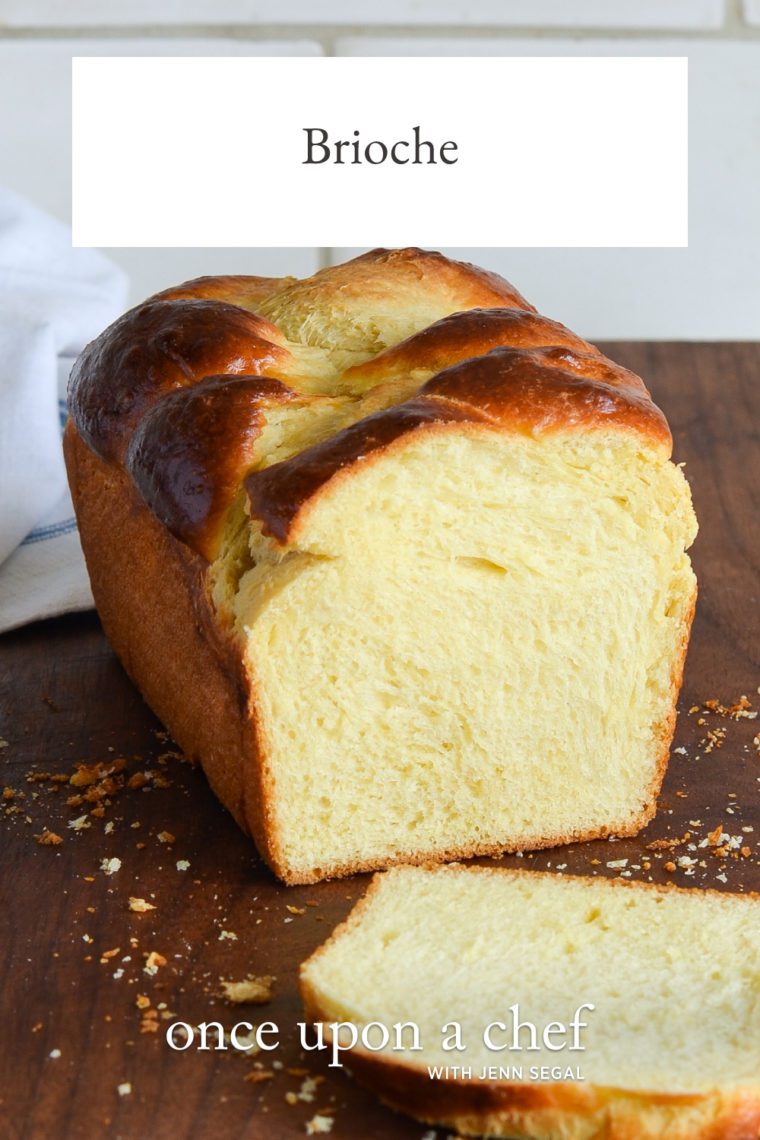
This post may contain affiliate links. Read my full disclosure policy.
With just a few simple steps and a little patience while the dough rises, you can make delicious homemade brioche—perfect for enjoying fresh with butter and jam, making sandwiches, or using as a base for French toast.
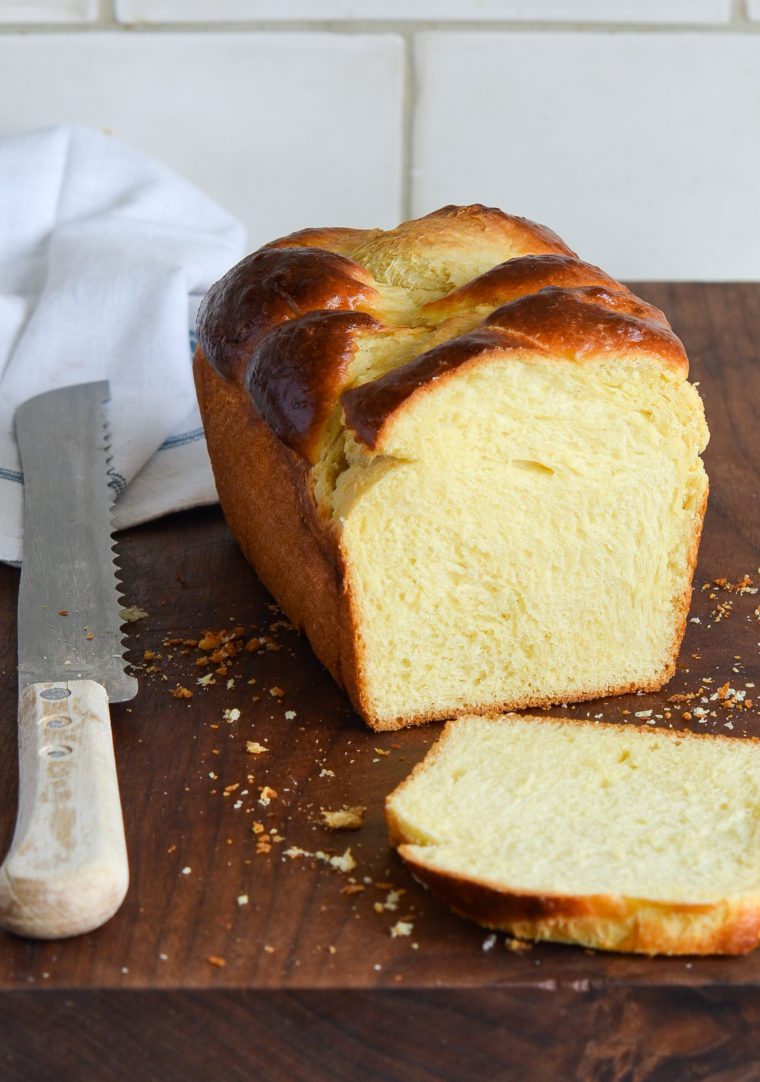
Brioche is a French bread with a fluffy interior, slightly sweet flavor, and shiny golden crust. Made with enriched dough—think butter, eggs, and sugar—it goes beyond the basic flour, salt, water, and yeast of white bread. These extras give brioche bread a rich, indulgent flavor that’s similar to challah but even richer.
This easy brioche recipe, modestly adapted from Artisan Bread in 5 Minutes A Day by Jeff Hertzberg M.D. and Zoë François, comes together quickly with just a brief knead. The dough does require some patience while it rises, so it’s best to start it a day ahead. The wait is absolutely worth it! The recipe makes two loaves, so you can enjoy one now and freeze the other for later. Leftover brioche makes a great base for French toast or bread pudding.
“Excellent brioche! It’s unbelievably soft and moist, and the rich buttery crust is delicious.”
What You’ll Need to Make Brioche Bread
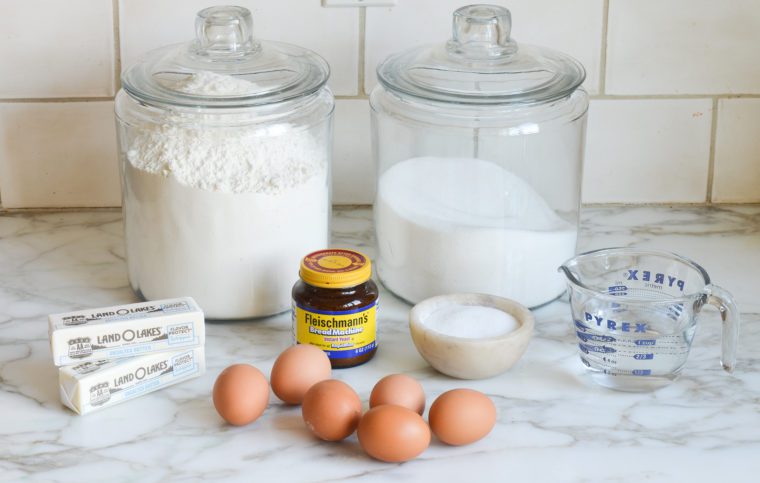
- Flour, Sugar & Salt: These pantry staples form the foundation of the dough. The flour creates the soft, rich structure; the sugar feeds the yeast and adds a hint of sweetness; and the salt balances the flavors so the bread doesn’t taste flat.
- Instant/Rapid-Rise Yeast: Makes the dough rise without needing to be proofed first. It’s easy to work with and gives reliable results.
- Eggs & Butter: These enrich the dough, giving brioche its signature tender crumb and buttery flavor. Most of the eggs and butter go into the dough itself, while one egg is reserved for a wash that gives the loaves their shiny, golden crust.
- Warm Water: Helps bring the dough together and activates the yeast so it can work its magic.
- Jump to the printable recipe for precise measurements
Step-by-Step Instructions
Step 1: Make the dough. In a large bowl, mix together the melted butter, warm water, sugar, salt, and yeast. Add 5 of the eggs and whisk until everything is well combined. Next, add the flour all at once and stir with a wooden spoon until the dough comes together. It’ll be wet, a little lumpy, and elastic (don’t worry—it’ll firm up in the fridge and smooth out when you knead it).




Step 2: Let the dough rise and chill. Cover the bowl loosely with plastic wrap and let it sit at room temperature for 2 hours. Then, refrigerate for at least 3 hours or up to three days.
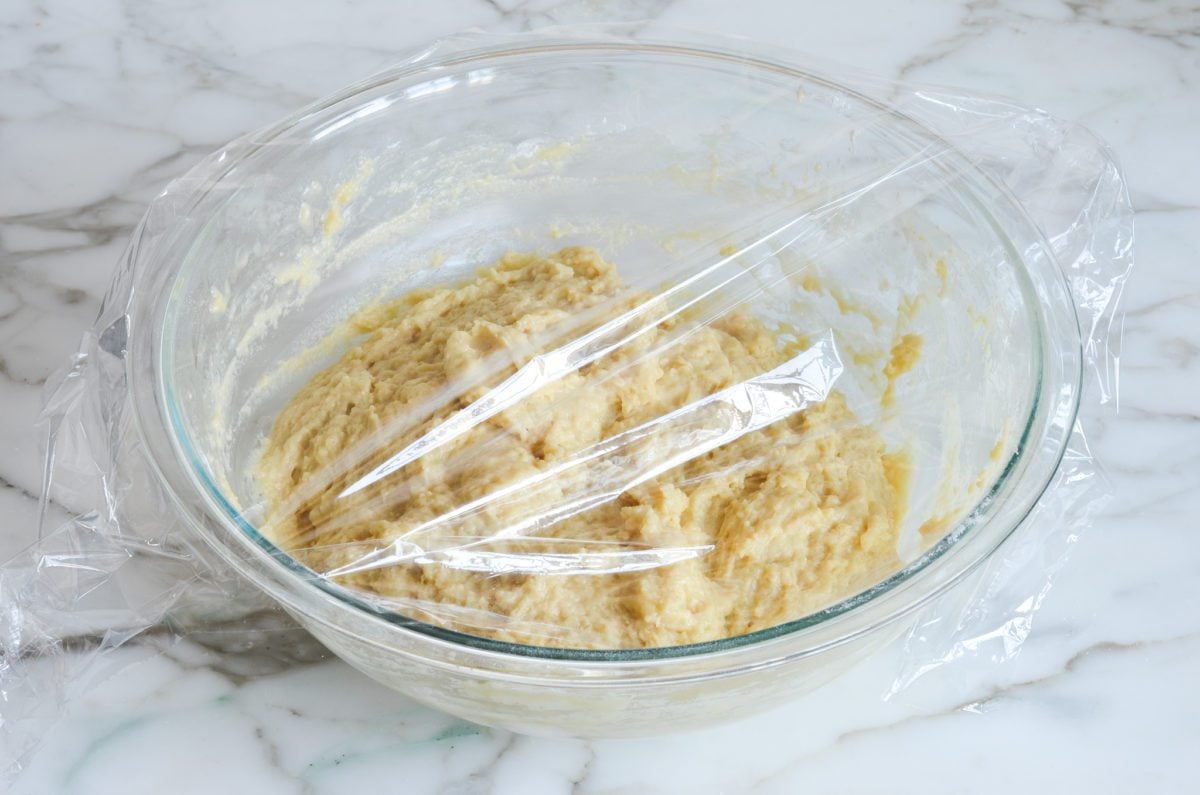
Step 3: Prep the dough for braiding. Pull out half of the dough and place on a lightly work surface. Dust the dough with more flour and knead for about 30 seconds. Divide the dough into 3 equal portions, then roll each one into a 13-inch strand.
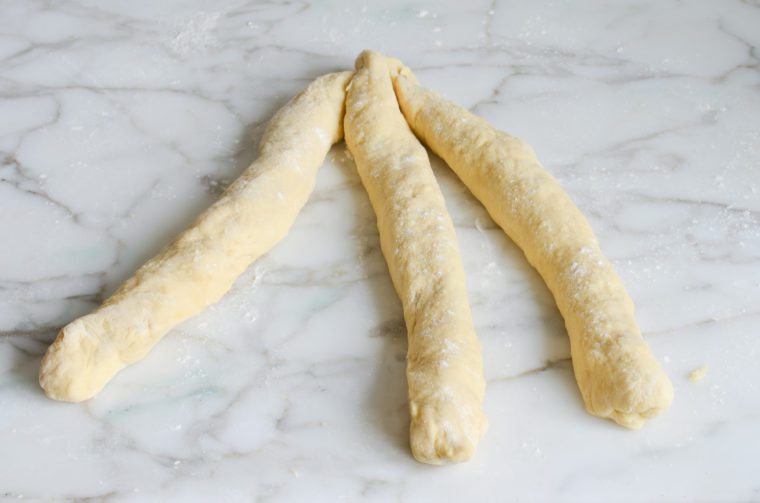
Step 4: Braid the loaf and let it rise. Pinch the three strands together at the top and braid them. Place the braided dough into a greased loaf pan, tucking the ends underneath. (If you prefer not to braid, just roll the dough into an oval and place it in the pan.) Cover loosely with plastic wrap and let it sit at room temperature for 90 minutes.


Step 5: Prep for baking. Preheat the oven to 350°F and set an oven rack in the middle position. Beat the remaining egg in a small bowl and brush it evenly onto the dough.
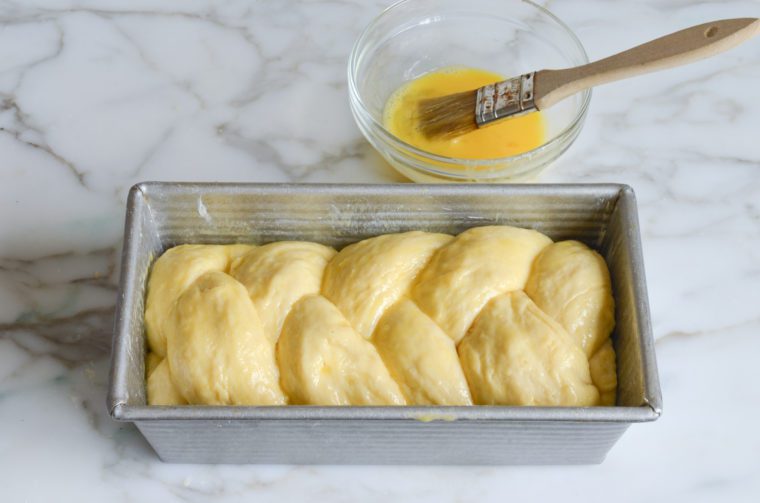
Step 6: Bake and cool. Bake the loaf for 45 to 50 minutes, until the bread is a rich golden brown. Let it cool in the pan on a rack for 15 minutes, then turn the loaf out and allow it to cool completely before slicing. Brioche is best enjoyed fresh on the day it is made, but it freezes well for up to 2 months. If you don’t plan to serve the whole loaf at once, consider slicing the bread or portioning it into a few larger pieces before freezing.


More Bread Recipes You May Like
Brioche Bread

Ingredients
- 1 cup (2 sticks) unsalted butter, melted and slightly cooled, plus more for greasing the pans
- 1 cup warm water (see note)
- ½ cup sugar
- 2¼ teaspoons salt
- 2 teaspoons instant/rapid-rise yeast
- 6 large eggs, divided (5 for dough and 1 for egg wash)
- 5½ cups all-purpose flour, spooned into measuring cup and leveled-off, plus more for kneading and braiding
Instructions
- In a large bowl, whisk together the melted butter, warm water, sugar, salt and yeast. Add 5 of the eggs and whisk until evenly combined. Add the flour all at once and stir with a wooden spoon until the mixture is uniform; it will be wet, lumpy, and a bit elastic (it will firm up in the fridge and smooth out when you knead it). Cover loosely with plastic wrap (make sure the entire bowl is covered but don't seal it airtight) and let sit at room temperature for 2 hours, then refrigerate for at least 3 hours or up to three days.
- On the day of baking, grease an 8½ x 4½-inch (21 x 11-cm) loaf pan with butter (or two loaf pans if you're baking both loaves at the same time). Dust a clean work surface generously with flour. Dust the dough in the bowl with flour and use a knife to cut it in half. Pull out half of the dough and place it on the floured work surface; cover the remaining half with plastic wrap (not airtight) and place it back in the refrigerator until ready to bake. (The dough can be used anytime within the 3-day window, or frozen in an airtight container for up to two weeks. When ready to use the frozen dough, thaw in the refrigerator for 24 hours before using, then continue with the next step.)
- Dust the dough with more flour and knead, sprinkling more flour as necessary so the dough doesn't stick, for about 30 seconds. Divide the dough into 3 equal portions (about 9 oz/255 g each) and, using your hands, roll each one into a 13-inch (33-cm) strand. Pinch the three strands together at the top and braid. Place the braided dough into the prepared loaf pan, tucking the ends underneath. (Alternatively, if you don't want to braid the dough, simply elongate it into an oval and place in the prepared pan.) Cover the pan loosely with plastic wrap (not airtight) and let sit at room temperature for 90 minutes. (It will rise just a bit.)
- Preheat the oven to 350°F (175°C) and set an oven rack in the middle position.
- Beat the remaining egg in a small bowl. Brush it evenly onto the dough (cover and refrigerate the remaining egg wash for the second loaf, or discard if not using within 2 days). Bake for 45 to 50 minutes, until the bread is a rich golden brown color. Let cool in the pan on a rack for 15 minutes, then turn out and let cool completely before slicing.
Notes
- Warm water helps activate the yeast. The temperature should be about 110°F (43°C), but it doesn't need to be exact, so no need to use a thermometer; just try to get it about the temperature of bath water.
- If you'd like to bake both loaves at the same time, allow a few extra minutes baking time.
Nutrition Information
This website is written and produced for informational purposes only. I am not a certified nutritionist and the nutritional data on this site has not been evaluated or approved by a nutritionist or the Food and Drug Administration. Nutritional information is offered as a courtesy and should not be construed as a guarantee. The data is calculated through an online nutritional calculator, Edamam.com. Although I do my best to provide accurate nutritional information, these figures should be considered estimates only. Varying factors such as product types or brands purchased, natural fluctuations in fresh produce, and the way ingredients are processed change the effective nutritional information in any given recipe. Furthermore, different online calculators provide different results depending on their own nutrition fact sources and algorithms. To obtain the most accurate nutritional information in a given recipe, you should calculate the nutritional information with the actual ingredients used in your recipe, using your preferred nutrition calculator.
See more recipes:
Comments
Add a Comment Cancel reply
This site uses Akismet to reduce spam. Learn how your comment data is processed.
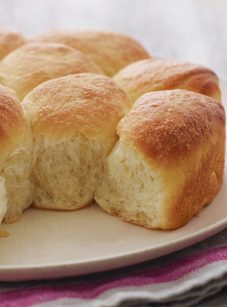
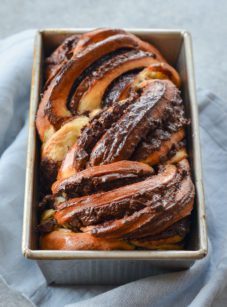


The recipe is flawless! Turned out perfect looks exactly like on the website on my first try ever making brioche. I needed 45 minutes on 170C. I halved the recipe and used 3 small eggs for the loaf. It’s so soft and fluffy inside, had doubts it was ready as I put in the thermometer but the reading was good and it was done!
Absolutely fabulous!
Upon taking the dough out of the fridge, the dough seemed quite lumpy and sticky. I could feel hardened lumps all throughout the dough as I was handling it. Is this normal?
I am now waiting to bake it in 90 minutes and will update on how it turned out later this evening.
Hi Alexandra, That doesn’t sound right — perhaps it wasn’t mixed properly? How did it come out?
The loaf turned out flawless! Just like the pictures.
I do agree that perhaps it was not mixed properly, but that did not seem to affect the final result at all. I will however try my best to mix it better next time and see if that makes any difference. Thank you Jenn! <3
All’s well that ends well — so glad to hear it came out well! 🙂
Hi Jen!
I made this bread. It was excellent! I froze part of the dough. Your recipe says the dough can be frozen for 2 weeks. It’s been 5 weeks for me. Can I still use this frozen dough or do I need to toss it? Please let me know! I’d really like to make it for my 90 year old mother. Thank you!
Denise
Hi Denise, it’s definitely at its best within the 2-week window, but it should still be fine. Hope your mom enjoys!
Best bread ever, and easy! Thank you for this fabulous recipe and great instructions! 🙂
Hi Jen, if I want to make this brioche with fresh yeast, what would the right amount be? Thanks.
Hi Ana Maria, I’ve never worked with fresh yeast, but I read the following on King Arthur Flour: To convert from fresh yeast to instant dry yeast, multiply the fresh quantity by 0.33. Instant yeast can be incorporated into the dough without first rehydrating it; however, it is sensitive to ice or ice-cold temperatures, and if the water temperature of the dough is cold, it is best to mix the dough for a minute or two before adding the yeast. In order to maintain dough yield, most manufacturers suggest making up the weight difference between dry yeast and fresh with additional water. You can check it out here.
I’ve made this three times in the last month. I am ever so amazed at how simple this dough is!! I love that the dough can rest for up to three days in the refrigerator and how I can make the Chocolate Babka (SO GOOD TOO!) very easily from one of the loaves. I am making this yet again and doing a blueberry Babka. The brioche is just so amazing!
Easier to make than the traditional method, a time saver for sure and the difference in texture is minimal. Great recipe!
I made this Sunday afternoon. It turned out perfect!! It’s like having dessert, froze a loaf and planning on an amazing French toast breakfast soon! I can’t believe bread that good was this easy
I have been eyeing this brioche recipe of yours for sometime and finally made it yesterday. It turned out beautiful and delicious …..reminded me of the bakeries in Paris!
I love all your recipies. Thank you🙏
I mistakenly left the dough out at room temp for four hours instead of two. Otherwise, followed the directions exactly and the bread came out beautiful and delicious!
OH MY GOODNESS! This is the first loaf of bread I have ever made, and boy was it wonderful! Better than I had hoped for. Too bad we can’t give more than 5 stars because this is a 10 for me!